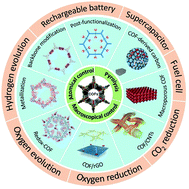Covalent organic frameworks (COFs) for electrochemical applications
Abstract
Covalent organic frameworks are a class of extended crystalline organic materials that possess unique architectures with high surface areas and tuneable pore sizes. Since the first discovery of the topological frameworks in 2005, COFs have been applied as promising materials in diverse areas such as separation and purification, sensing or catalysis. Considering the need for renewable and clean energy production, many research efforts have recently focused on the application of porous materials for electrochemical energy storage and conversion. In this respect, considerable efforts have been devoted to the design and synthesis of COF-based materials for electrochemical applications, including electrodes and membranes for fuel cells, supercapacitors and batteries. This review article highlights the design principles and strategies for the synthesis of COFs with a special focus on their potential for electrochemical applications. Recently suggested hybrid COF materials or COFs with hierarchical porosity will be discussed, which can alleviate the most challenging drawback of COFs for these applications. Finally, the major challenges and future trends of COF materials in electrochemical applications are outlined.

- This article is part of the themed collection: New frontiers in covalent organic frameworks: design and applications


 Please wait while we load your content...
Please wait while we load your content...